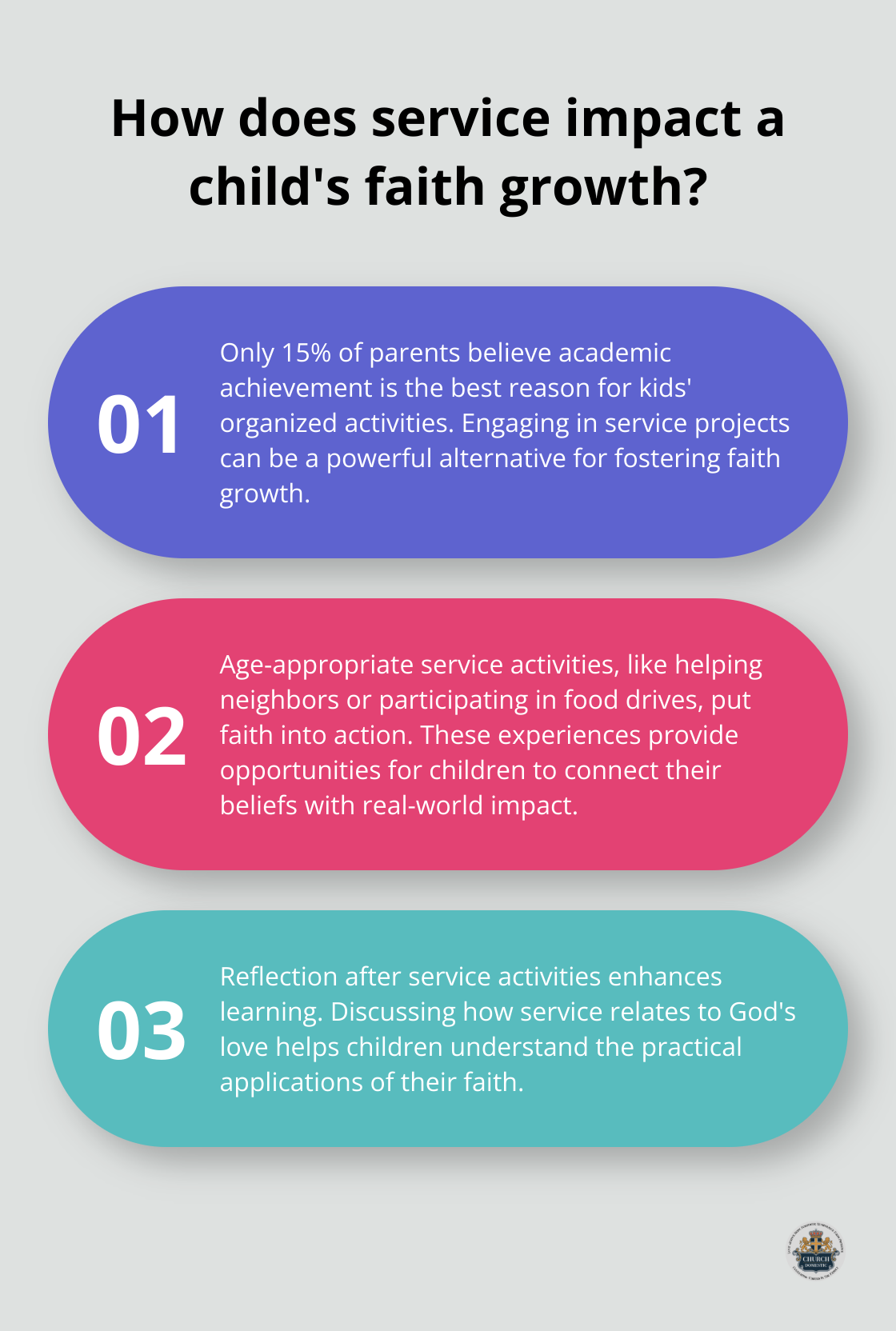At Church Domestic, we believe spiritual growth is the cornerstone of a strong family foundation. Nurturing faith within your household can create lasting bonds and provide guidance through life’s challenges.
In this post, we’ll explore practical strategies to foster spiritual development for every family member. From establishing daily routines to creating a faith-friendly home environment, these tips will help you cultivate a rich spiritual life together.
How to Build a Strong Family Faith Routine
A consistent family faith routine forms the foundation of spiritual growth. Regular practices can transform family dynamics and deepen faith connections. Here’s how you can create a meaningful routine that works for your family:
Set a Daily Prayer Time
Choose a specific time each day for family prayer. This could be in the morning before everyone leaves, or in the evening when you’re all together. Keep it short and simple, especially if you have young children. Even five minutes of focused prayer can make a significant impact.

A study by the Barna Group found that 70% of U.S. parents worry about their children staying true to their faith as they grow. Regular prayer time can address this concern by making faith a natural part of daily life.
Make Scripture a Family Activity
Add Bible reading to your family’s routine in creative ways. For younger children, use illustrated Bible stories at bedtime. With older kids and teens, try a verse-of-the-day app that you can discuss over breakfast or dinner.
Research indicates that individuals who recalled frequent religious attendance as a child were less likely to have changed central faith views. Make it interactive by taking turns reading aloud or acting out stories for younger members.
Engage in Age-Appropriate Faith Discussions
Create opportunities for open conversations about faith. For younger children, this might mean asking simple questions about God’s love or creation. With teenagers, you can explore more complex topics like applying faith to current events or personal challenges.
A survey by the Pew Research Center found that 65% of highly religious parents discuss religion with their children at least a few times a week. These discussions help children develop their own understanding and relationship with faith.
Use Technology Wisely
Use technology to support your family’s faith routine. Numerous apps and online resources exist for daily devotionals, Bible study, and even virtual prayer groups. The YouVersion Bible app (a popular choice among many families) offers family plans that make it easy to read and discuss scripture together, even when you’re not in the same place.
Consistency is the key to success. Start small and build up gradually. It’s better to have a short, daily practice that everyone can join than an elaborate routine that’s hard to maintain. As you establish these habits, faith will become an integral part of your family’s daily life, fostering spiritual growth for everyone involved.
Now that you’ve laid the groundwork for a strong family faith routine, it’s time to explore how you can integrate these practices into your everyday life. The next section will provide practical tips on finding teachable moments, encouraging acts of kindness, and modeling faith-based decision-making in your daily experiences.
Living Faith Daily
Faith isn’t just for Sundays-it’s a daily practice that transforms families. This chapter explores how to weave spiritual principles into your everyday routines, creating a rich tapestry of faith-filled experiences.
Capture Everyday Moments for Spiritual Growth
Life offers countless opportunities to discuss faith. A beautiful sunset becomes a chance to marvel at God’s creativity. Your child’s struggle with a friend opens a door to explore forgiveness and kindness through a faith lens.
Engaging in daily religious practices at home and modeling faith through actions rather than just words are effective strategies to strengthen family faith. Make it your mission to highlight God’s work in your daily lives.
Embrace Kindness as a Family Mission
Acts of kindness bring faith to life. Set a family goal to perform one kind act each day. Help a neighbor with groceries or write a heartfelt thank-you note to a teacher. These simple actions not only express your faith but also help your children build positive relationships. Research shows that better coparenting relationship quality is associated with children’s positive social and emotional development.
Demonstrate Faith-Based Decision Making
Children learn best through example. When faced with decisions (big or small), explain your thought process out loud. Show how faith influences your choices.

For instance, when deciding between extra work hours or family time, discuss how your values guide you. This transparency helps children understand faith as a practical life guide.
Foster a Culture of Gratitude
Gratitude forms the bedrock of faith and offers daily practice opportunities. Start a family gratitude journal or make sharing blessings a dinnertime ritual.
People who practice gratitude consistently report numerous benefits, including stronger immune systems and increased positive emotions. A focus on gratitude not only expresses faith but also enhances your family’s overall well-being.
Use Technology to Support Faith
Harness the power of technology to reinforce your family’s faith journey. Numerous apps and online resources offer daily devotionals, Bible study guides, and even virtual prayer groups. These tools (when used wisely) can supplement your family’s spiritual practices and make faith accessible in our digital age.
As you integrate these practices into your daily life, you’ll find that faith becomes more than a concept-it becomes a lived experience. The next chapter will explore how to create a physical environment in your home that supports and nurtures this daily faith journey.
How to Create a Faith-Filled Home
Your home serves as the primary environment where your family’s faith takes root and flourishes. Intentionally shaping your living space can significantly impact your family’s spiritual growth. Here’s how you can transform your home into a haven that nurtures faith:
Design a Sacred Space
Create a dedicated area for prayer and reflection. This doesn’t require an entire room-even an unused corner of an extra room or basement will do. Select a quiet spot and furnish it with comfortable seating, soft lighting, and items that inspire contemplation. Hang up posters or photos that generate a sense of calm and quiet, and include religious texts, prayer beads, or a journal for personal reflections.

A study by the Pew Research Center found that 55% of Americans pray daily. A designated prayer space can increase this frequency within your family. Make this area accessible to all family members, encouraging its use throughout the day.
Surround Yourself with Meaningful Symbols
Place religious artwork or symbols thoughtfully to serve as constant reminders of your faith. Consider hanging a cross in your entryway or placing an icon in your living room. These visual cues can spark conversations about faith and serve as touchpoints for family discussions.
The National Study of Youth and Religion reports that teenagers who live in homes where religious symbols are present are more likely to remain religiously active as adults. Choose pieces that resonate with your family’s beliefs and aesthetics.
Curate an Inspiring Media Library
In today’s digital age, your home’s media collection plays a key role in shaping your family’s mindset. Build a library of faith-based movies and other media that appeal to all age groups. Consider titles like “Where Hope Grows,” “The Visual Bible: The Gospel of John,” “God’s Not Dead,” “Full Count,” “Hillsong: Let Hope Rise,” and “Overcomer” for your collection.
According to the Barna Group, 73% of practicing Christian parents express concern about media influences on their children. A positive media environment can counteract negative influences and reinforce your family’s values.
Create a Family Faith Wall
Dedicate a wall in your home to display your family’s faith journey. Include Bible verses, prayer requests, and photos of meaningful spiritual moments (such as baptisms or mission trips). This visual representation of your family’s faith can serve as a daily reminder and conversation starter.
Establish a Faith-Based Routine
Incorporate faith into your daily home routine. This could include saying grace before meals, reading a daily devotional together, or ending the day with a family prayer. Consistency in these practices can help make faith a natural part of your family’s everyday life.
Final Thoughts
Spiritual growth in families requires dedication, creativity, and patience. You must establish consistent faith routines, integrate spiritual practices into daily life, and create a faith-friendly home environment. These actions will lay the foundation for a rich and meaningful spiritual life for every family member.

Each family’s spiritual journey is unique, so tailor your approach to your family’s specific needs and dynamics. Experiment with different practices and adjust your strategies as your family grows and changes. The goal is to create a sustainable, authentic spiritual life that resonates with everyone.
At Church Domestic, we support you with resources, insights, and encouragement as you nurture your family’s faith. Our blog offers information on family life (including practical tips for spiritual growth and fostering strong family bonds). Implement these strategies and watch as your family’s faith deepens and flourishes.